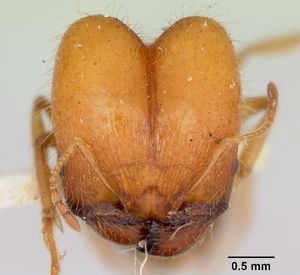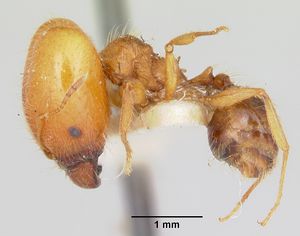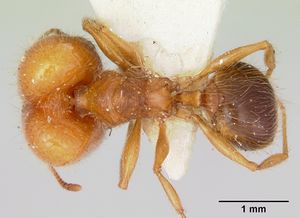Pheidole virago
| Pheidole virago | |
|---|---|

| |
| Scientific classification | |
| Kingdom: | Animalia |
| Phylum: | Arthropoda |
| Class: | Insecta |
| Order: | Hymenoptera |
| Family: | Formicidae |
| Subfamily: | Myrmicinae |
| Tribe: | Attini |
| Genus: | Pheidole |
| Species: | P. virago |
| Binomial name | |
| Pheidole virago Wheeler, W.M., 1915 | |
Extremely rare. Wheeler’s type series were from nests in open sandy soil, marked by 1-cm-wide entrances surrounded by craters of sandy soil 8 to 12 cm across. Ingham (1959, 1963; unpublished theses quoted by Allred 1982), reported virago at 900 m in southern Utah, in desert and semidesert, variously with creosote bush, bur sage, rabbitbrush, cholla, marigold, and Russian thistle, forming crater nests in open soil. However, the Utah records are doubtful and need field confirmation. (Wilson 2003)
Identification
The majors of this species are large, with a head length (excluding mandibles) at least 2 mm in length, usually more. The pronotum of the major is covered with transverse striae, the posterior half of the head is without sculpture. (Mackay and Mackay 2002)
See the description in the nomenclature section.
Keys including this Species
Distribution
Texas to Arizona. (Wilson 2003)
Latitudinal Distribution Pattern
Latitudinal Range: 37.28° to 18.639867°.
| North Temperate |
North Subtropical |
Tropical | South Subtropical |
South Temperate |
- Source: AntMaps
Distribution based on Regional Taxon Lists
Nearctic Region: United States (type locality).
Distribution based on AntMaps
Distribution based on AntWeb specimens
Check data from AntWeb
Countries Occupied
| Number of countries occupied by this species based on AntWiki Regional Taxon Lists. In general, fewer countries occupied indicates a narrower range, while more countries indicates a more widespread species. |

|
Estimated Abundance
| Relative abundance based on number of AntMaps records per species (this species within the purple bar). Fewer records (to the left) indicates a less abundant/encountered species while more records (to the right) indicates more abundant/encountered species. |

|
Biology
The nests of this species are in the soil, with a small mound (7 - 13 cms diameter). The nest entrance is large (1.2 cms), suggesting they are preyed upon by army ants (Neivamyrmex). Colonies are small and contain only a few workers. (Mackay and Mackay 2002)
Castes
Worker
Major
Images from AntWeb
   
| |
| Cotype of Pheidole virago. Worker (major/soldier). Specimen code casent0103484. Photographer April Nobile, uploaded by California Academy of Sciences. | Owned by LACM, Los Angeles, CA, USA. |
Nomenclature
The following information is derived from Barry Bolton's Online Catalogue of the Ants of the World.
- virago. Pheidole virago Wheeler, W.M. 1915b: 401 (s.w.) U.S.A. See also: Wilson, 2003: 604.
Unless otherwise noted the text for the remainder of this section is reported from the publication that includes the original description.
Description
From Wilson (2003): DIAGNOSIS A very large, reddish brown (major) to reddish yellow (minor) member of the pilifera group.
Major: anterior third of head completely carinulate, with some carinulae that originate on the frontal lobes almost reaching the occiput; pronotum and mesonotal convexity completely covered by transverse carinulae; in dorsal-oblique view, promesonotal profile evenly trilobous; a small metanotal convexity present; the propodeal spines large and perpendicular to the basal propodeal face; postpetiole seen from above very broad and conulate.
Minor: dorsal surface of head and sides of mesosoma longitudinally carinulate; pronotal dorsum covered by a mix of longitudinal carinulae and rugulae; propodeal spines perpendicular to basal propodeal face; dorsal margin of petiolar node strongly convex; postpetiolar node depressed.
MEASUREMENTS (mm) Lectotype major: HW 2.02, HL 2.20, SL 0.84, EL 0.20, PW 0.90. Paralectotype minor: HW 0.60, HL 0.66, SL 0.64, EL 0.12, PW 0.40.
COLOR Major: concolorous light reddish brown.
Minor: reddish yellow.
Figure. Upper: lectotype, major. Lower: paralectotype, minor. Scale bars = 1 mm.
Type Material
ARIZONA: Santa Cruz River, Tucson, col. W. M. Wheeler.. Museum of Comparative Zoology - as reported in Wilson (2003)
Etymology
L virago, female warrior. (Wilson 2003)
References
- Wilson, E. O. 2003. Pheidole in the New World: A dominant, hyperdiverse ant genus. Harvard University Press, Cambridge, MA. (page 604, fig. major, minor described)
- Allred, D. M. 1982. Ants of Utah. Great Basin Nat. 42: 415–511.
- Ingham, C. D. 1959. Ants of the Virgin River Basin, southwestern Utah. Thesis. U. of Utah. 140 pp.
- Ingham, C. D. 1963. An ecological and taxonomic study of the ants of the Great Basin and Mojave Desert regions of southwestern Utah. Dissertation. U. of Utah. 212 pp.
- Mackay, W. P. and E. Mackay. 2002. The ants of New Mexico (Hymenoptera: Formicidae). Edwin Mellen Press, Lewiston, NY.
- Varela-Hernández, F., Medel-Zosayas, B., Martínez-Luque, E.O., Jones, R.W., De la Mora, A. 2020. Biodiversity in central Mexico: Assessment of ants in a convergent region. Southwestern Entomologist 454: 673-686.
- Wheeler, W. M. 1915b. Some additions to the North American ant-fauna. Bull. Am. Mus. Nat. Hist. 34: 389-421 (page 401, soldier, worker described)
References based on Global Ant Biodiversity Informatics
- Allred D. M. 1982. Ants of Utah. The Great Basin Naturalist 42: 415-511.
- Allred, D.M. 1982. The ants of Utah. Great Basin Naturalist 42:415-511.
- Wheeler, G.C. and J. Wheeler. 1985. A checklist of Texas ants. Prairie Naturalist 17:49-64.
- Wilson, E.O. 2003. Pheidole in the New World: A Dominant, Hyperdiverse Genus. Harvard University Press



